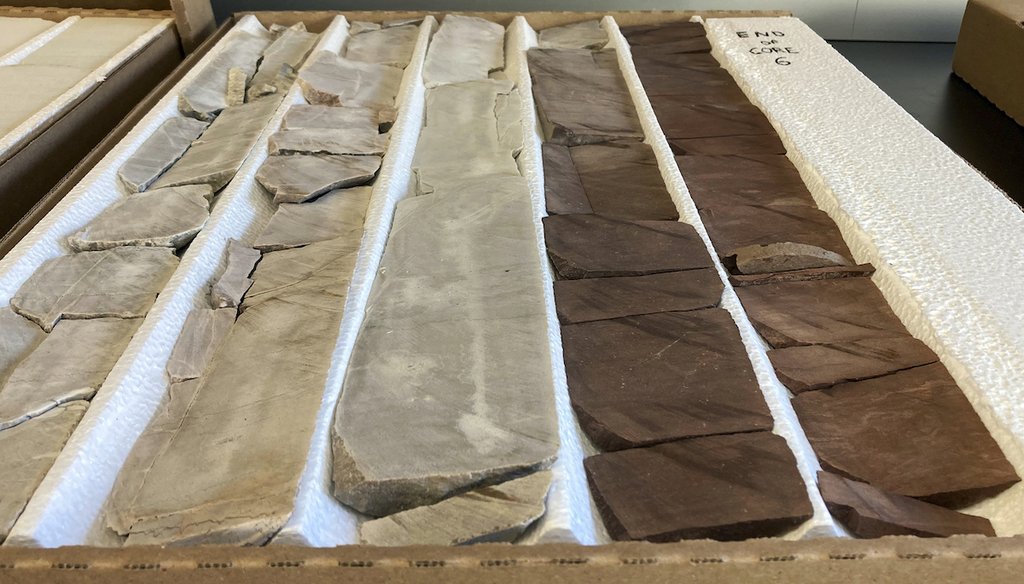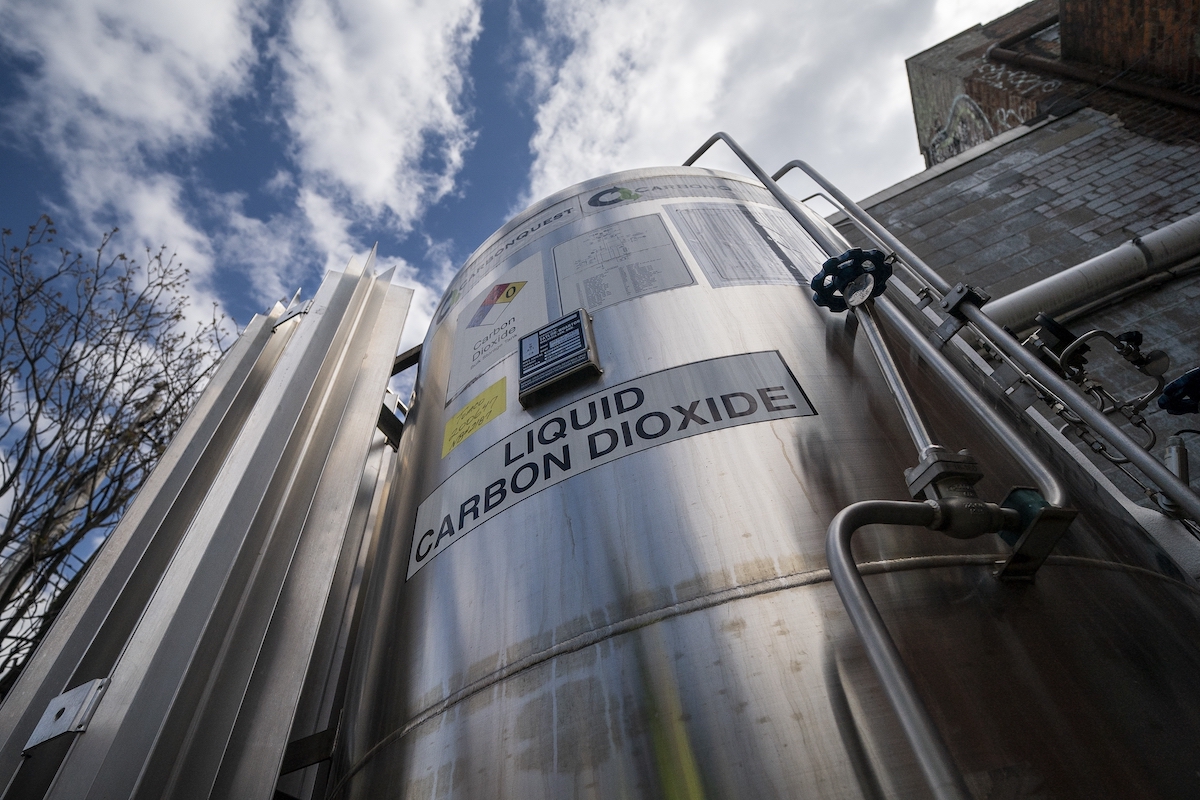Stand up for the facts!
Our only agenda is to publish the truth so you can be an informed participant in democracy.
We need your help.
I would like to contribute

Rock samples taken from an almost 2-mile-deep well drilled in northeastern Wyoming to study the potential for storing carbon dioxide underground are displayed in a University of Wyoming School of Energy Resources lab. (AP)
If Your Time is short
-
"Carbon capture and storage" reduces the amount of carbon dioxide from fossil fuel emissions that gets into the air by capturing and storing it, typically underground.
-
The Biden administration has allocated billions of dollars to promote carbon capture and storage initiatives.
-
Some climate change activists say carbon capture and storage technology can enable more burning of fossil fuels and create other environmental risks.
Is it possible for a climate change solution to reduce emissions while simultaneously enabling more polluting?
That’s the question underlying carbon capture and storage, technology designed to catch and store carbon dioxide from sources such as power plants before it reaches the air.
The Biden administration has earmarked billions of dollars for carbon capture and storage initiatives.
But even as some cheer what is referred to as "CCS" for reducing emissions, critics fear it could perpetuate global dependence on types of energy sources that create the most pollution from carbon dioxide, or CO2.
"The obvious pros of CCS are that you are preventing CO2 from entering the atmosphere," said Hugh Daigle, a University of Texas petroleum and geosystems engineering professor whose research specialties include carbon storage. "The cons are that you are not reducing emissions to zero; the technologies can be expensive to implement; and many people worry that CCS will simply prolong our use of fossil fuels when perhaps we should be moving to other carbon-free sources of energy."
Sign up for PolitiFact texts
What is carbon capture and storage?
Carbon capture and storage involves catching CO2 emissions from, for example, a gas- or coal-fired power plant, before they are released into the air.
The CO2 is then stored, typically underground, though it can also be used in operations such as oil extraction or beverage carbonation.
Carbon dioxide accounts for 79% of U.S. emissions of greenhouse gases, which are produced when fossil fuels such as coal and oil are burned for energy. Most of the world’s scientists agree that greenhouse gases released into the atmosphere from human activity are driving climate change.
Recent National Oceanic and Atmospheric Administration data suggests an increasing need for carbon capture technology. Carbon dioxide levels measured in May were among the highest on record.
How is Biden funding carbon capture?
Carbon capture and storage might not be part of most people’s climate change vocabulary, but it is attracting billions of dollars in federal funds from the Biden administration — and it seems to have captured a measure of support from folks in both major political parties.
The 2021 bipartisan infrastructure law provided $7 billion for carbon management, including nearly $3.5 billion for demonstration projects that improve large-scale carbon capture.
The law won votes from 19 Republicans in the Senate and 13 in the House. Carbon capture has won backing from energy interests such as the American Petroleum Institute, which has emphasized bipartisan support in Congress.
Also, the 2022 Inflation Reduction Act expanded tax credits by $12 billion for underground storage structures and for CO2 use in enhanced oil recovery.
An increase in what is known as the 45Q tax credit in the Inflation Reduction Act aims to persuade more companies to do carbon capture and storage projects. It raises the credit to $85 per metric ton from $50 for carbon that is stored; and to $60 from $35 for carbon that is used.
Daigle said the two laws "go a long way towards making CCS profitable, or at least cost-neutral."
Biden has promised to put the U.S. on the path to net-zero — when the release and capture of greenhouse gases are in balance — by 2050.
"I think there’s a practical reality that the globe is going to be using gas and coal for the foreseeable future," said Jeremy Harrell, chief strategy officer at ClearPath, a Washington, D.C.-based nonprofit that promotes policies reducing and removing energy emissions. "We need to be worried about reducing the carbon emissions from those."
Planned projects can move the U.S. toward Biden’s goal. In June 2022, the University of North Dakota’s Energy and Environmental Research Center partnered with Red Trail Energy, an ethanol plant in southwestern North Dakota, to launch a carbon capture and storage facility. It injects carbon more than a mile underground.
Harrell said six demonstration projects that are scheduled to get federal funding in the fall are expected to show "substantial improvements in the efficiency, effectiveness, cost and environmental performance" of carbon capture.
The pros of carbon capture and storage
Carbon capture and storage represents a relatively small part of efforts to mitigate climate change, but the federal government and some leading international climate advocates see it as crucial to reaching zero-emission goals by 2050.
Every year, carbon capture storage projects are storing the equivalent of CO2 emissions created by 10 million passenger cars, according to the Massachusetts Institute of Technology.
The Energy Department said in an April report that the United States "leads the world" with its 20 million metric tons per year of carbon capture capacity, but that represents 5% or less of what the U.S. could need by 2050. The federal incentives from the inflation reduction and infrastructure laws make private investment more likely to be profitable and will lead to "meaningful scale in carbon management," the report said.
The global capacity is 40 million metric tons, according to the Global CCS Institute, which promotes carbon capture.
The International Energy Agency, a Paris-based intergovernmental organization, said carbon capture and storage is "virtually the only technology solution for deep emissions reductions from cement production," and is vital for reducing emissions from other heavy industry.
The United Nations’ Intergovernmental Panel on Climate Change said in its 2022 annual report that carbon capture and storage is an important strategy for mitigating climate change.
In 2023, Sultan al-Jaber, who will oversee the United Nations’ COP28 climate summit in November, called for scaling up carbon capture technologies.
Al-Jaber, CEO of the Abu Dhabi National Oil Co., has also said the world must cut emissions by 7% per year.
And the Massachusetts Institute of Technology reports that some carbon capture and storage projects globally have exceeded 95%.
ClearPath’s Harrell said that among climate solutions, carbon capture is "near the very top of the list, given that there are not many alternatives to solving emissions reductions, particularly in heavy industry. If we’re going to have any shot at realistically meeting net-zero emissions globally, reducing emissions from existing infrastructure is going to have to be a critical component of that."
And Daigle, the Texas professor, said carbon capture and storage has "shown great promise over several decades of demonstration projects."
The cons of carbon capture and storage
Some experts are skeptical whether carbon capture can meet lofty expectations.
A September 2022 report by the Institute For Energy Economics and Financial Analysis, an Ohio-based research nonprofit, said many carbon capture projects fall short of snagging the 90% of emissions they promise. The Shute Creek carbon capture project in Wyoming, for example, captured only 36%, the group reported.
Only one carbon capture and storage facility has been used on a power plant in the U.S., a coal-fired plant near Houston. The Institute For Energy Economics and Financial Analysis has questioned the claim by the facility, Petra Nova, that it met its pledge to capture 90% of carbon emissions.
Petra Nova operated from 2017 to 2020, injecting CO2 into a field to boost oil production. It shut down when oil prices plummeted, but is expected to reopen in 2023.
Dennis Wamsted, an energy analyst with the Institute For Energy Economics and Financial Analysis, said it’s far from clear that carbon capture can work on a large scale. He said he puts carbon capture and storage "pretty far down the ladder" for climate solutions.
Carbon capture and storage is also "a way for the fossil fuel industry to say, ‘Give us more time, we promise we’ll get better down the road,’" Wansted said. "We don't have time down the road. We need to be building nonemitting sources," such as wind and solar, "rather than trying to clean up really dirty sources."
Atlas Public Policy, a Washington, D.C.- and San Francisco-based research nonprofit, said many see the technology as enabling more pollution by fossil fuel companies "by serving as an offset or a distraction, rather than encouraging a transition to clean energy."
Even if carbon capture and storage effectively captures emissions, postponing the end of the use of fossil fuels also worries some public health officials because of other effects, such as air pollution on coal workers.
In May, a study published in the journal Environmental Research: Health estimated that air pollution from U.S. oil and natural gas production caused $77 billion in health impacts in 2016.
Technological risks and hidden costs
There are also environmental risks beyond the capture process itself.
Leakage from underground storage of carbon dioxide can occur, but technology is available to detect small leaks and to remedy any leaks before they threaten humans or the environment, according to researchers from the Energy Department’s Lawrence Berkeley National Laboratory in California.
Another risk comes from pipelines. At least 45 people were hospitalized, mostly with respiratory problems, after a carbon dioxide pipeline in Mississippi ruptured in 2020. Some of the people poisoned used oxygen tanks for months afterward.
How soon some of the carbon capture and storage projects will be on line remains to be seen.
The S&P Global Ratings research firm reported June 8 that companies that pursue carbon capture "face considerable uncertainties about financial costs," but that each of the 25 oil companies it reviewed plan to use carbon storage, carbon direct removal, or carbon credits to meet their decarbonization goals.
RELATED: Billions of dollars are being invested in pricey ‘green’ hydrogen. Is it a viable climate solution?
RELATED: Show the green: States ranking high in renewable energy jobs gave generous incentives
RELATED: What role does natural gas play in a ‘clean energy’ future? Separating spin from science in TV ads
RELATED: US versus China: Which nation is doing more to address climate change?
RELATED: New electric vehicle tax credit rules aim to reduce dependence on China, but present new obstacles
Our Sources
Massachusetts Institute of Technology, "Carbon capture," Jan. 20, 2023
Massachusetts Institute of Technology, "How efficient is carbon capture and storage?", Feb. 23, 2021
Clean Air Task Force, "Carbon capture provisions in the Inflation Reduction Act of 2022," accessed June 13, 2023
CNN, "COP28 president says fossil fuels still have a role to play, prompting concerns about climate summit’s goals," May 3, 2023
PolitiFact, "CO2 is only 0.04% of the atmosphere, but a viral video ignores that it’s a major climate threat," April 21, 2023
PolitiFact, "Copious evidence proves climate change is not a ‘fraud,’" Jan. 31, 2023
International Energy Agency, "About CCUS," April 2021
American Petroleum Institute, "Rejecting myths about CCUS, supporting a critical bipartisan technology," Feb. 18, 2022
Fast Company, "Should we reduce or remove greenhouse gas emissions? Why not both?", June 1, 2023
Global CCS Institute, "What is carbon capture and storage and how does it work?", accessed June 14, 2023
Boston Globe, "Carbon capture isn’t the climate change health benefit the world needs," June 1, 2023
Roll Call, "Carbon capture, a federal spending target, has much to prove," March 6, 2023
Embassy of the United Aram Emirates, "COP28 President-Designate Emphasizes Importance of Energy Industry as Part of Solution at COP28," March 8, 2023
The New York Times, "How does carbon capture work?", March 19, 2023
Forbes, "Second shot at carbon capture from coal burner to revive oil reservoir In Texas - Petra Nova do-over," Feb. 20, 2023
Environmental Research: Health, "Air pollution and health impacts of oil & gas production in the United States," May 3, 2023
Climate Nexus, "Geoengineering Basics," accessed June 2, 2023
American University, "Carbon Removal Glossary," April 15, 2020
National Oceanic and Atmospheric Administration, "Broken record: Atmospheric carbon dioxide levels jump again," June 5, 2023
Climate Program Portal, "Federal support for carbon capture," May 31, 2023
Lawrence Berkeley National Laboratory, "Detection and options for remediation of leakage from underground CO2 storage projects," accessed June 13, 2023
Energy Department, "Biden-Harris administration announces $4.9 billion to deploy infrastructure necessary to manage and store carbon pollution," Sept. 23, 2022
Energy Department, "Pathways to commercial liftoff: carbon management," April 2023
University of North Dakota, "Carbon capture and storage: From dream to reality," Nov. 1, 2022
Politico, "A crucial climate technology provokes fears in oil country," May 16, 2023
Institute For Energy Economics And Financial Analysis, "The ill-fated Petra Nova CCS project: NRG Energy throws in the towel," Oct. 5, 2022
Institute For Energy Economics And Financial Analysis, "Proposed CCS projects need careful review for cost, technology risks," May 10, 2023
Interview, Dennis Wamsted, energy analyst with the Institute For Energy Economics And Financial Analysis, an Ohio-based research nonprofit, June 9, 2023
Institute For Energy Economics and Financial Analysis, "Carbon Capture: CCS | CCUS | CCU," Sept. 12, 2022
S&P Global Ratings, "Carbon capture, removal, and credits pose challenges for companies," June 8, 2023
Intergovernmental Panel on Climate Change, "Climate change 2022: mitigation of climate change," April 2022
Email, Hugh Daigle, University of Texas petroleum and geosystems engineering professor, who research specialties include carbon storage, June 8, 2023
Interview, chief strategy officer Jeremy Harrell at ClearPath, June 9, 2023
Reuters, "Factbox: Emerging carbon capture projects at U.S. power plants," May 12, 2023






























